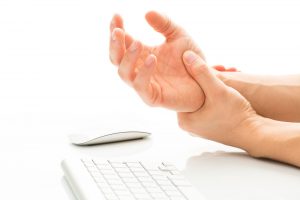Treating Arthritis
Treating Arthritis with Acupuncture
Although acupuncture has been around for thousands of years, Western medicine is only recently beginning to understand how it may beused to treat the symptoms of a variety of chronic conditions. Generally well-recognized as an effective treatment for chronic pain, more and more patients are considering it for other chronic conditions, including treating arthritis with acupuncture.
What Is Arthritis?
According to the Arthritis Foundation, over 53 million Americans suffer from the disease, making it the leading cause of disability in the  United States. There is no cure.
United States. There is no cure.
This chronic disease is marked by swelling and stiffness of the joints, which may be worse in the morning or after exercise. There are numerous types of arthritis, but osteoarthritis (OA) and rheumatoid arthritis (RA) are the most common. Pain does not always accompany the disease.
Risk of arthritis increases with age. With the population aging rapidly, researchers expect the impact of arthritis to become even greater.
Research Supports Arthritis Treatment with Acupuncture
Although proving or disproving the effectiveness of acupuncture through scientific methods presents a challenge, numerous studies have been conducted.
The NCBI, which is a branch of the National Institute of Health (NIH) and National Library of Medicine (NLM), compiled ten of the most conclusive studies that look at acupuncture and osteoarthritis of the knee. In all, these trials represent 1,456 participants and meet the stringent criteria of scientific study (i.e. control groups and diverse participant demographics). These findings support acupuncture as an effective treatment for both pain and physical dysfunction associated with OA of the knee.
Findings also suggest that acupuncture participants experienced significantly greater pain relief than those whose treatment relied on pharmacologic pain management (pain pills).
The Prescription Drug Alternative with No Side Effects
Western acupuncture models relieve pain by releasing neurochemicals through stimulation of specific points in the body. This sends impulses to the patient’s spinal cord, which activates three centers in the brain to release endorphins and monoamines, neurochemicals that block pain messages.
Western medicine has already shifted to a growing acceptance of acupuncture as a valid medical treatment. In 1997, the NIH concluded that acupuncture is effective at treating the side effects of chemotherapy and postoperative dental pain. In addition, many insurers now cover acupuncture treatment.
There is also growing acceptance of and interest in non-pharmacological methods for treating pain. The highly addictive nature of opioids makes them dangerous for many patients. In addition, they have numbers side effects, including constipation and liver damage, that are not an issue with acupuncture.
If you would like to learn more or schedule your first acupuncture treatment,contact us today.
